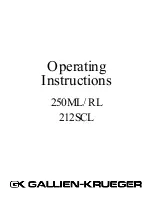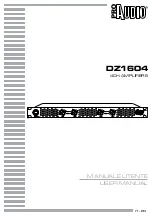
SETTING INPUT SENSITIVITY
1. Initially turn the INPUT LEVEL control(s) to
the minimum (counterclockwise) position.
2. On the source unit, increase the volume
control to 3/4 volume. Slowly increase the
INPUT LEVEL control(s) toward three o’clock
until you hear slight distortion in the music.
Then reduce the INPUT LEVEL slightly until
distortion is no longer heard.
NOTE:
After the source unit is on, blue LEDs (on
the top panel) will light, indicating the amplifier
is on. If not, check the wiring, especially the
remote connection from the source unit. Also
refer to “Troubleshooting.”
REMOTE LEVEL CONTROL
The 1300a, 1600a and 5350a include a remote
level control. This will allow the subwoofer level
to be adjusted from the listening position.
Connect the remote level control using the
RJ11 jack on the side of the amplifier. Install
the control module in the front of the vehicle
within easy reach of the driver. Both the under-
side of the dash and the center console are
suitable locations.
UNDER-DASH MOUNTING
Select a mounting location that allows easy
access to the control while driving. Using the
REMOTE LEVEL control as a template, mark and
drill holes in the mounting surface. Attach the
REMOTE LEVEL control using the mounting
screws provided (Figure 11).
Figure 11
. Under-dash mounting of the
REMOTE LEVEL control.
Refer to the illustrations on the previous pages
for control location.
Reconnect the (–) negative lead to the vehicle’s
battery. Apply power to the audio system and
play a dynamic music track.
SETTING THE CROSSOVER(S)
Determine your system plans and set the
crossover-mode switch accordingly. If your
system design does not include a subwoofer,
set the crossover mode to FULL and skip to
“Setting Input Sensitivity.”
If your system includes a subwoofer, set the
crossover mode to HP (high-pass) for your
full-range speakers. Adjust the crossover
frequency to limit bass, and provide increased
system volume with less distortion.
Mode Switch:
Full:
Allows a full-range signal through to the
speakers; can be used with larger full-range
speakers such as 6" x 9"s.
HP:
Allows a high-pass signal through to
the speakers; should be used with most
loudspeakers (can protect your full-range
speakers from being overdriven with low
frequencies, one cause of speaker damage).
LP:
Allows only bass to pass through to the
speakers; should be selected when powering
subwoofers.
High-Pass Filters:
Initially set the crossover-
frequency control midway. While listening
to music, adjust the crossover for the least
perceived distortion from the speakers, allowing
them to reproduce as much bass as possible.
Low-Pass Filters:
For subwoofers, choose
the highest frequency that removes vocal
information from the sound of the subwoofer.
If using the 475a to drive a subwoofer(s), set
the crossover mode to LP (low-pass) on the
channels connected to the subwoofer.
NOTE:
The 1300a, 1600a and the subwoofer
output of the 5350a are low-pass only and
do not have a crossover-mode switch.
I
NSTALLATION AND
S
ETUP
Route the cable behind the dash or other
interior panels and under the carpet. Do not
route the cable outside the vehicle. Connect the
RJ11 cable between the RJ11 receptacle on the
amp and the receptacle on the REMOTE LEVEL
control (Figure 12).
Figure 12
. REMOTE LEVEL control electrical
connection.
SETTING THE BASS BOOST
The Bass Boost control will allow you to enhance
the bass output of your system at 50Hz up to 6dB.
AUX OUTPUT
Reference amplifiers (except 5350a) are
equipped with full-range outputs that can be
used to connect additional amplifiers.
STATUS LEDs
Power:
Indicates the amplifier is on.
Protection:
Refer to “Troubleshooting” for specific
indications.
Figure 13.
LED status.
T
ROUBLESHOOTING
• PROBLEM:
No audio (POWER LED is off).
CAUSE and SOLUTION: No voltage at BATT+
and/or REM terminals, or bad or no ground
connection. Check voltages at amplifier
terminals with VOM.
• PROBLEM:
No audio (PROTECT LED glows red).
CAUSE and SOLUTION: DC voltage on amplifier
output. Amplifier may need service; see
enclosed warranty card for service information.
• PROBLEM:
No audio (PROTECT LED glows red).
CAUSE and SOLUTION: Amplifier is overheated.
Make sure amplifier cooling is not blocked at
mounting location; verify that speaker-system
impedance is within specified limits.
• PROBLEM:
No audio (PROTECT LED glows red).
CAUSE and SOLUTION: Voltage less than 9V on
BATT+ connection. Check vehicle charging system.
• PROBLEM:
No audio (PROTECT LED glows red).
CAUSE and SOLUTION: Voltage greater than
16V or less than 8.5V on BATT+ connection.
Check vehicle charging system.
• PROBLEM:
Distorted audio.
CAUSE and SOLUTION: Input sensitivity is
not set properly, or amplifier or source unit is
defective. Check INPUT LEVEL setting, or check
speaker wires for shorts or grounds.
• PROBLEM:
Distorted audio (PROTECT LED glows
intermittently).
CAUSE and SOLUTION: Short circuit in speaker
or wire. Remove speaker leads one at a time to
locate shorted speaker or wire, then repair.
• PROBLEM:
Music lacks “punch.”
CAUSE and SOLUTION: Speakers are not
connected properly. Check speaker connections
for proper polarity.
5
5350a
Reference
Series
Содержание Reference 5350A
Страница 9: ...8 5350a Reference Series...
Страница 10: ...9 5350a Reference Series...
Страница 11: ...10 5350a Reference Series...
Страница 18: ...17 5350a Reference Series...







































